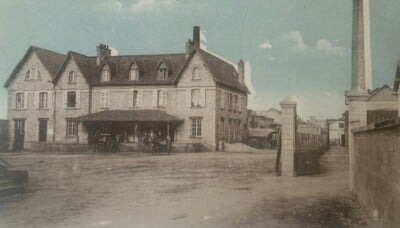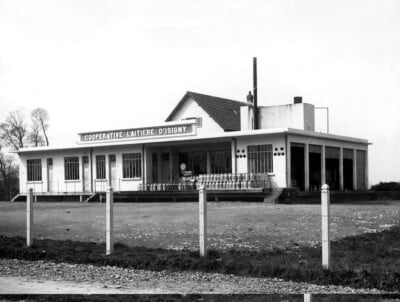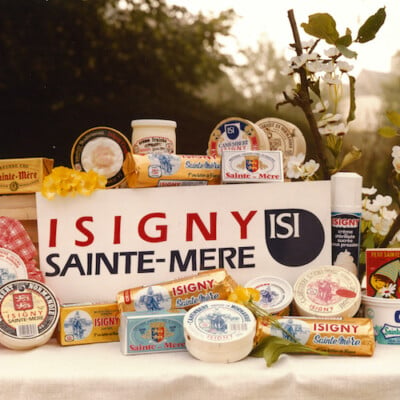Our history
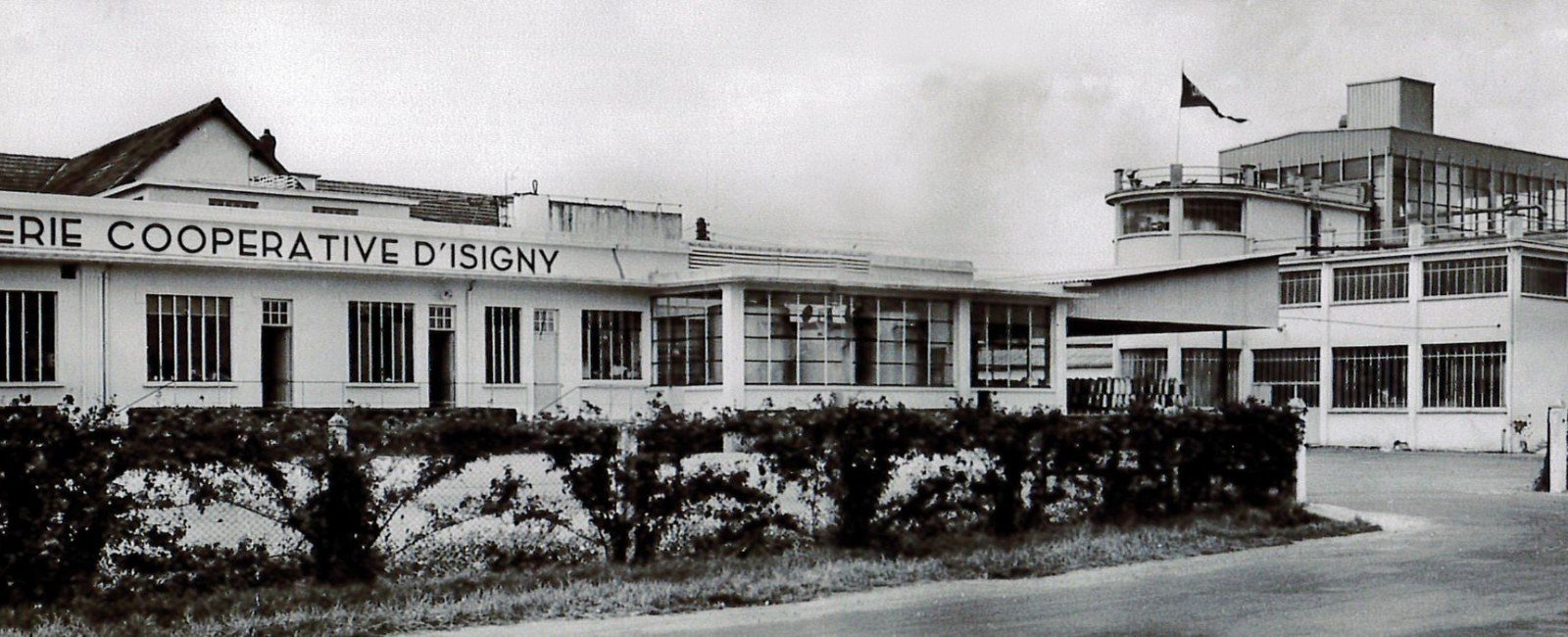
At Isigny Sainte-Mère, we care deeply about history, our own, of course, but also that of our terroir and of the Men and Women who helped lay the foundations of our Cooperative over a century ago.
The history of our Cooperative began long before it was created!
It was Saturday 3 June 1909, and the weather was exceptionally cool that year. This did not, however, prevent a few dairy owners from the small village of Sainte-Mère-Église and from the Cotentin peninsula from coming together to find a way to enhance the value of the milk from a terroir they already knew to be so exceptional. That was how they laid the first stones and established the outlines of our Isigny Sainte-Mère Cooperative as we know it today.
That morning, 50 forward-thinking milk producers who truly believed in the project of the “Sainte-Mère-Église dairy cooperative”, did not hesitate for a moment to mortgage their farms in order to raise a capital of 60,000 francs. This capital was then invested in constructing a factory in Chef-du-Pont, near the Paris-Cherbourg railway line. The idea behind this project—transporting and selling dairy products to Paris—was already taking shape.
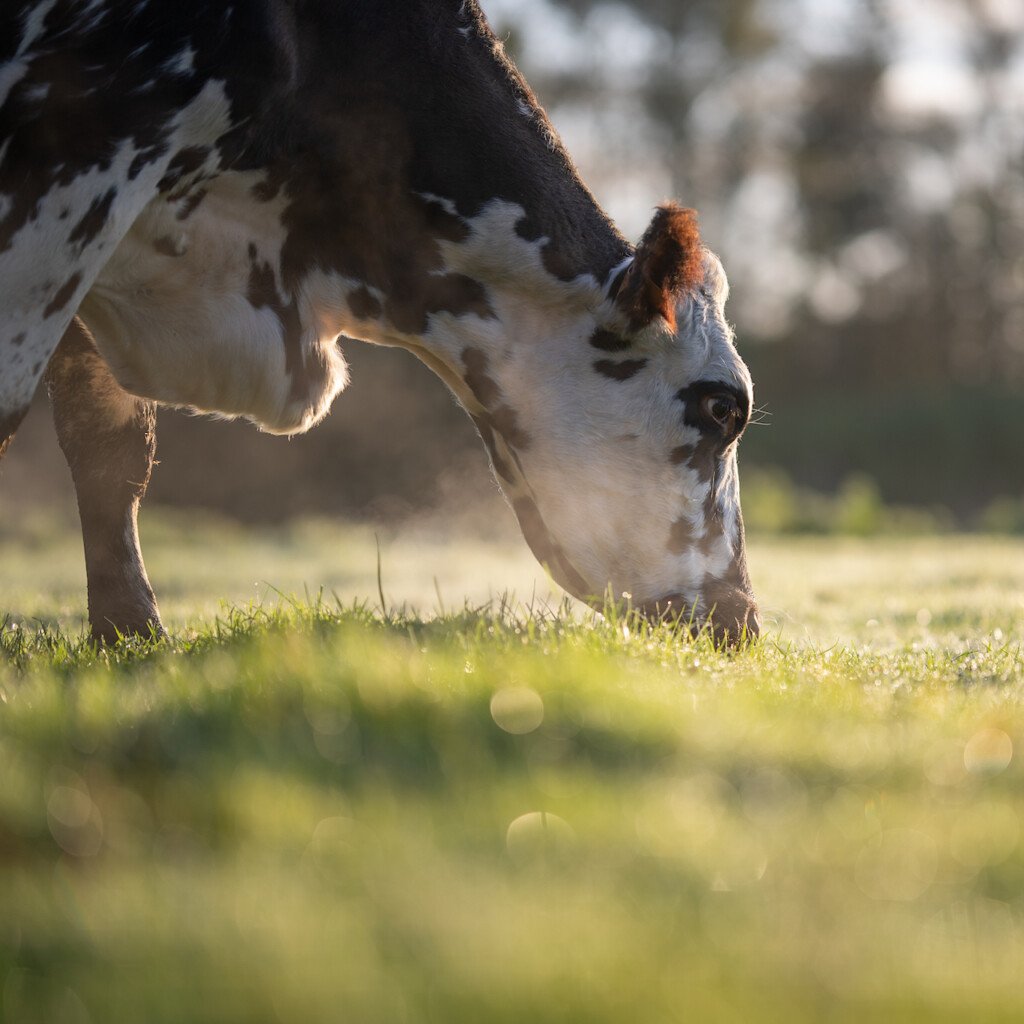
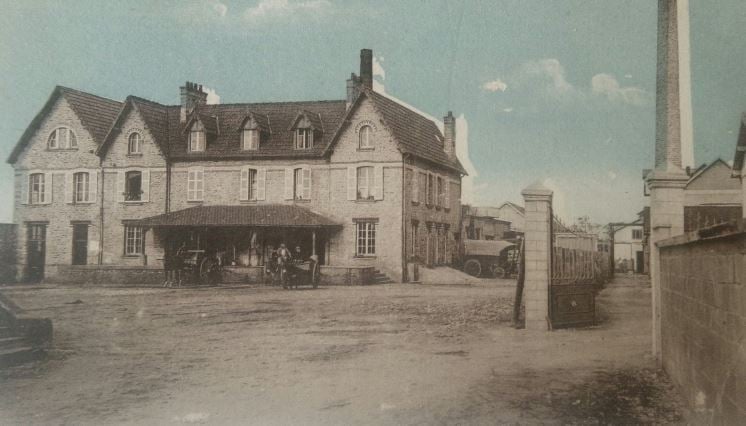
The early days of the Sainte-Mère-Église Dairy Cooperative
On 3 June 1909, dairy owners from Sainte-Mère-Église and the Cotentin peninsula met in Sainte-Mère-Église to create what would become, a few years later, the Sainte-Mère-Église and Cotentin dairy cooperative.
On 15 June 1910, the Sainte-Mère-Église Dairy Cooperative received 20 horse-drawn carriages carrying 11,000 litres of milk from 90 farms.
These first litres of milk were processed in the Cooperative’s factory to produce 500 kilos of Butter. Less than a year later, 200 member producers joined the venture and the collection reached 6 million litres!
In 1932, 42 milk producers located around the town of Isigny-sur-Mer also decided to join forces and pool their milk to produce and market butter, establishing the Isigny-sur-Mer dairy cooperative.
On 1 January 1980, the Sainte-Mère-Église dairy cooperative and the Isigny-sur-Mer dairy cooperative united. Their name became the UCL (Union des Coopératives Laitières d’Isigny Sainte-Mère – Union of the Isigny Sainte-Mère dairy cooperatives).
In 1980, the Sainte-Mère-Église/Chef-du-Pont dairy and the Isigny-sur-Mer dairy united, and were soon joined by the Périers and Juaye-Mondaye dairy cooperatives, expanding the union.
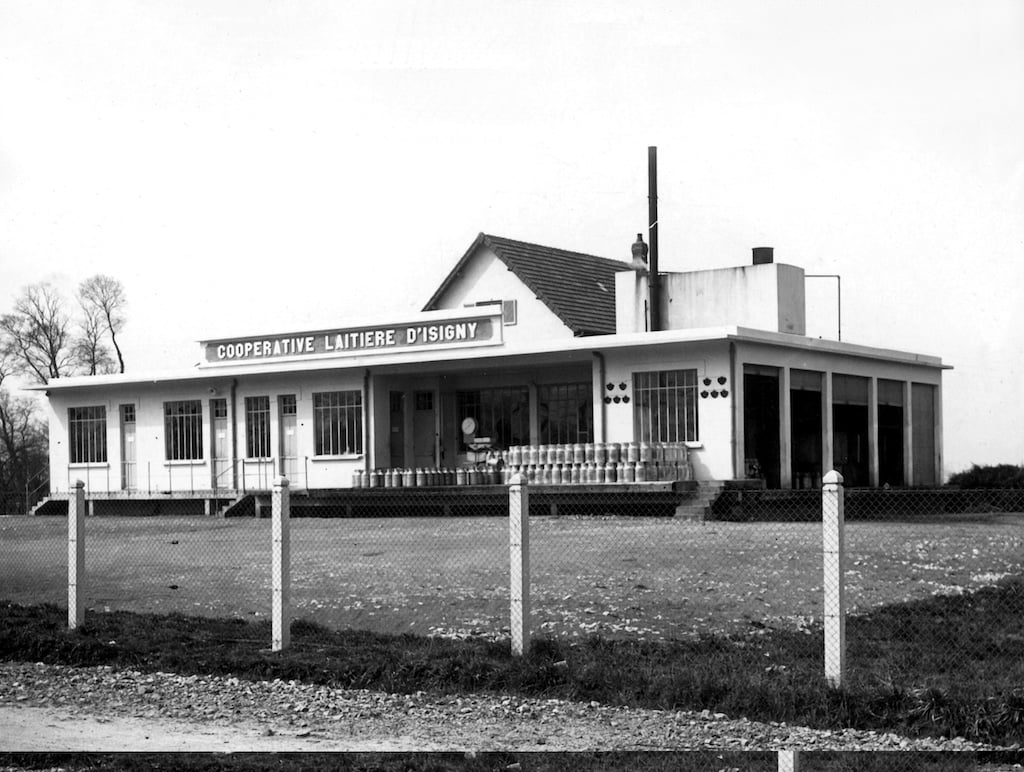
In 2000, the two Cooperatives merged to form the single entity “Isigny Sainte-Mère Cooperative”.
Diversification… under occupation
On 6 June 1944, almost 35 years to the day since the Cooperative was set up, milk collection began as normal at 8.00 am. However, that morning, planes roared over the Isigny terroir, and a few minutes later, the factory was machine-gunned by two aircraft.
The Battle of Normandy had broken out. In March, German troops decided to flood the marshes as a trap for American paratroopers, thereby making it impossible for the animals to reach the pastures. Milk production ceased abruptly, but the Cooperative Dairy quickly recovered from this dark period and returned to pre-war production by the 1950s.
The Cooperative, where tradition meets modernity
After the end of the Second World War, the Sainte-Mère-Église dairy cooperative decided to open a shop under the Cooperative’s trading name in Paris, rue Saint-Denis, near Halles de la Villette.
This was a strategic location, as many goods passed through Les Halles de Paris in order to feed the capital.
Demand for our products continued to grow in the Paris region, in particular, and northern France. Our milk collection kept up accordingly and new members joined the Cooperative. From 1975 onwards, the farms were gradually equipped with refrigerated tanks.
Previously, milk was collected in 20-litre containers and picked up every day. Using these containers for the collection was gradually stopped in the late 1990s. It has since been carried out entirely by tankers.
Milk refrigeration directly on the farm in milk tanks and its transportation in insulated tankers help preserve its properties and qualities, and ensure compliance with the health and safety requirements applicable to this raw material: milk.
Obtaining the Isigny Butter and Cream AOC
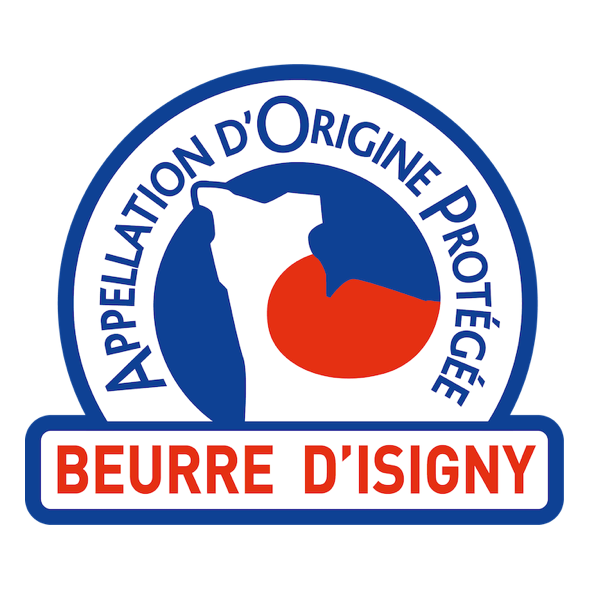
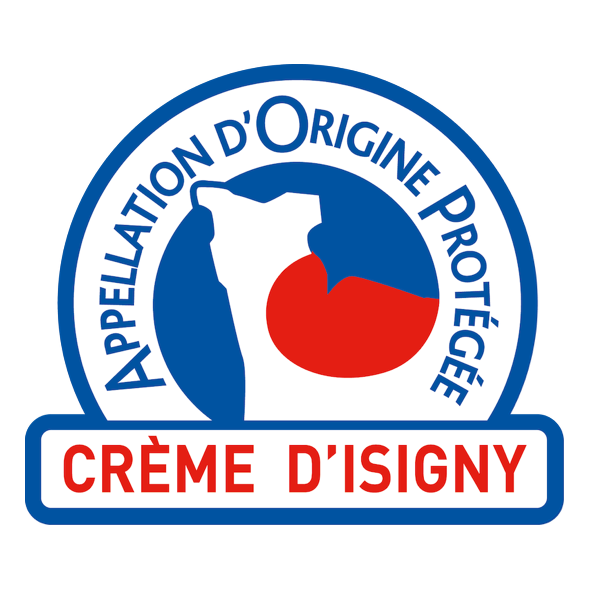
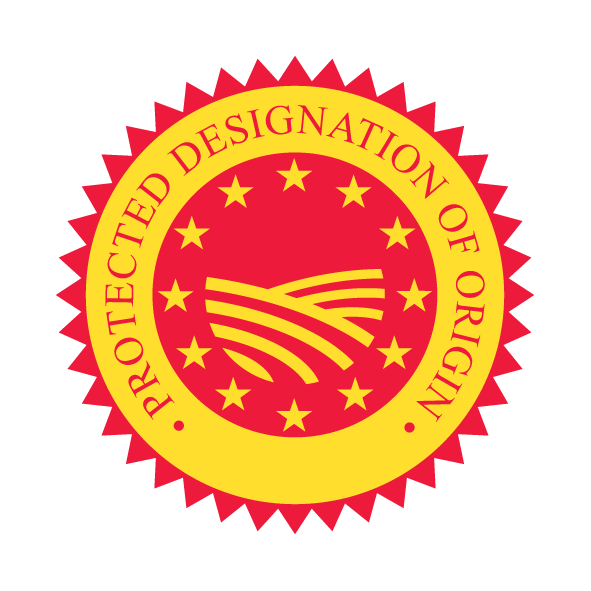
Labels stating Appellation d’Origine Contrôlée or Protected Designation of Origin (AOC or PDO) came into being at the beginning of the last century, to distinguish typical products associated with a terroir and the traditional know-how of their producers. These designations involve a new approach to quality, defined by a specific feature, associated with a unique region.
In the early 1980s, official recognition of the quality and terroir of Isigny became a matter of urgency. The reason for this was that the Isigny brand was being used, appropriated even, by numerous butter producers. There were “Isigny Butters” being manufactured much further north, and some competitors saw no problem with harming its reputation by creating poor-quality butters, stamped “Isigny Butter”.
Protecting the Isigny name, and thereby protecting the quality and terroir, became a priority. Daniel Delahaye (former Director of the Cooperative) decided to apply for the Protected Designation of Origin (PDO) label, but it was not that simple.
Fortunately, he had stayed in touch with his former professor for fraud control studies, Mr Cogitore, who had gone on to become a National inspector for fraud control. They arranged to meet and Mr Cogitore agreed to guide the Cooperative in obtaining the PDO for Isigny Butter and Cream.
In order to demonstrate the quality and long-standing history of our terroir, the Director of fraud control advised Mr Delahaye to recruit a student from an engineering school and to assign them a study aimed at highlighting the evidence of the specific nature and quality of Isigny milk. Roger Desnouveaux, an engineering student at the time, was chosen. His findings were surprising, he discovered that, like a fine wine, there is indeed a legitimate Isigny terroir.
The Director then contacted the French National Institute of Origin and Quality (INAO) and outlined the Isigny area. The first obstacle was a legal constraint of the INAO requiring that the process of obtaining the PDO be collective in order to serve the common interest.
The Cooperative approached its colleagues who were likely to be affected by the Isigny Butter & Cream PDO and created the “Isigny Butter and Cream Syndicate”. This syndicate was responsible for leading the project and submitting the specifications to the INAO.
With the support of Mr Guillaume, President of the Saint-Hubert dairy, and Minister of Agriculture at the time, the PDO label was awarded to the “Isigny Butter and Cream Syndicate” in less than two years. This was a huge success for the Cooperative!
The Isigny Butter and Cream AOC was thus finally granted a PDO in 1986.
Obtaining the Camembert AOC
In 1983, a decree recognised the Normandy origin of Camembert, by granting it the Appellation d’Origine Contrôlée (AOC – controlled label of origin). Normandy Camembert was born! The aim was to combine respect for traditional know-how with new production methods in order to preserve the flavours and sensory properties of Camembert. Milk producers and processors came together in an interprofessional syndicate advocating for Normandy AOC Camembert, to which our Cooperative still belongs today.
In 1984, our Cooperative developed a handling machine capable of automatically performing the mould-ladling process in order to improve the production of traditional Camembert cheeses (guaranteeing the highest hygiene standards and avoiding arduous work). This involved making use of automated production methods while respecting traditional know-how. A team of specialists from the Cooperative developed a prototype, which was tested and quickly shown to be successful. This innovation, which has now been adopted by major companies in the sector, allows several ladles to be operated simultaneously. The process still complies with the traditional rate of moulding and of draining the curds, taking their delicate nature, so characteristic of soft cheeses, into account. It thereby preserves the full Camembert flavour.
The Cooperative is also the story behind a brand
The symbol of our cooperative, found on the labels of our products, is of course the milkmaid proudly riding her donkey.
It was originally a drawing, inspired by the milkmaids found on a lot dairy-product packaging at the time. These young women, who were tasked with hand milking and collecting the valuable churns of milk, were nicknamed “triolettes”.
Henri Babeur (managing director of the Cooperative) was determined to immortalise this “triolette”, and in 1934 asked his youngest daughter, who played an active role working on the farm, to take on the role. Sitting proudly on her donkey, Marthe became the young model of the Isigny dairy.
However, capturing the picture was not easy: “The most difficult part was getting the donkey’s head to tilt to match the original drawing.”
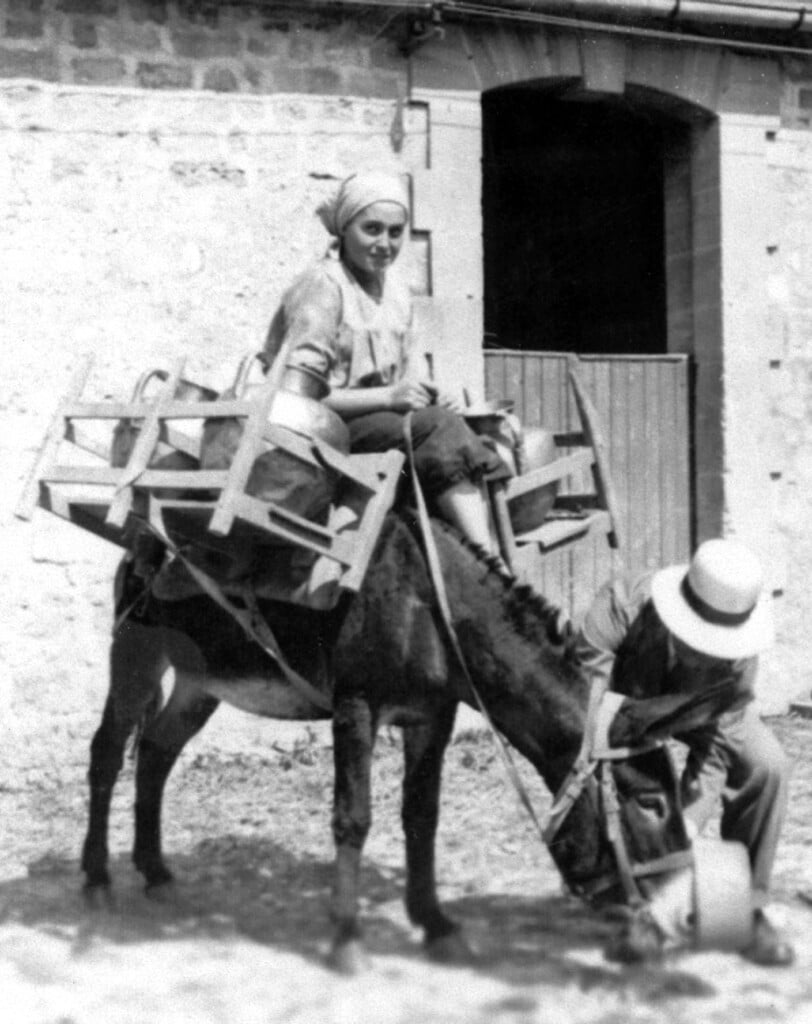
The brand evolved over the years and the famous Milkmaid now has a necklace and her clothes have been modernised. It was taken out of circulation in 1974, but made a comeback in 1990 and still embodies the unique identity that makes Isigny Sainte-Mère an authentic brand, recognised throughout the world.
Isigny Sainte-Mère around the world
Although products from the Isigny terroir have always been shipped around the world (the Vikings, for a start, took them on their campaigns!), 1977 marked a turning point.
Under the leadership of Daniel Delahaye (General Manager of Coopérative Isigny Sainte-Mère from 1974 to 2023), our Cooperative entered into contracts with American distributors who wanted to import the products of our exceptional terroir into the United States. This marked our dairy’s arrival on American soil, where we are still present today.
However, exports really surged starting in the early 1980s with Great Britain. Gradually, the Cooperative established partnerships with British distributors who loved the “French Taste of Normandy” to which we can lay claim. The Cooperative was truly pioneering, being the first to sell “Crème fraîche” on the Anglo-Saxon market.
Asia also opened its doors in 1985 with Hong Kong and Japan, which identified with the Cooperative’s values, history, approach, rigour, and, of course, its PDO products. A Camembert production factory was even set up in Hokkaido, Japan.
The fresh goods gradually made their way into Japan’s finest shopping malls. Camembert cheeses, considered a luxury product, are enjoyed on toast in the morning or offered during a dinner party or as a gift.
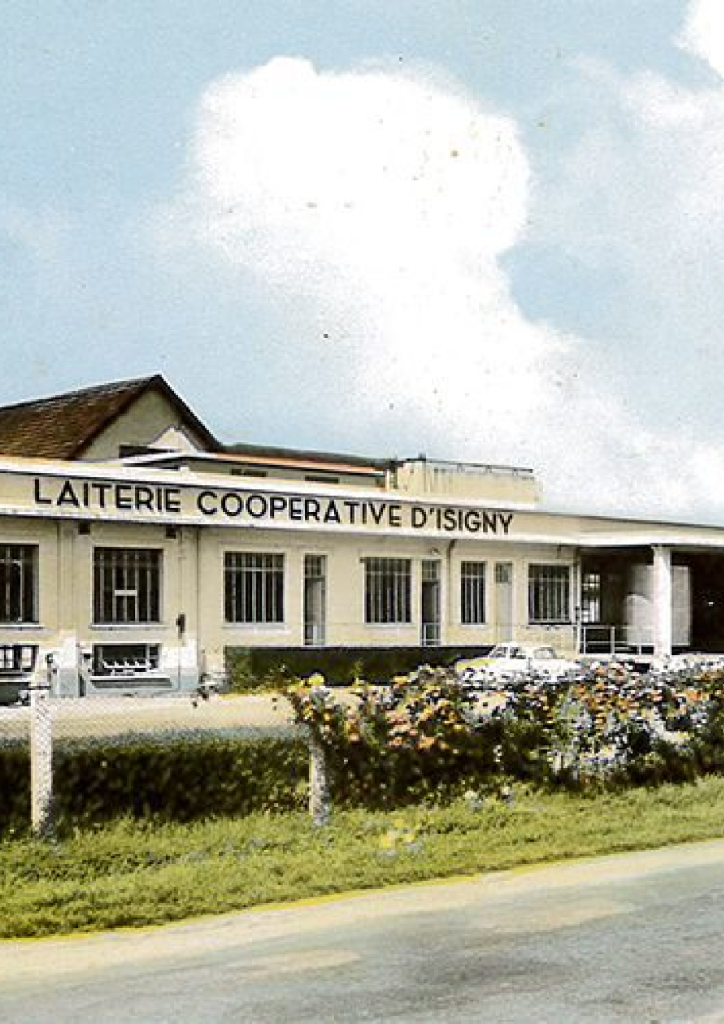
Today, products from our Isigny terroir are exported to more than 100 countries around the world.
From milk to milk powder
Milk powder, and infant milk powder in particular, were a natural choice, being so closely linked to the know-how of our Isigny Sainte-Mère Cooperative: a very high-quality raw material and an innate sense of innovation.
This business now represents more than 60% of our turnover and is more important than ever.
The milk collected from our producers is skimmed and this milk is recovered and processed into premium milk powders. We have built this expertise up over the decades. We have been developing milk powder for human consumption since 1949. Since 1957, we have also been manufacturing milk powder for infants for our customers in France (since the 1990s) and around the world (since 1957).
The history of our milk powder began just after the war. At the time Henri Babeur encouraged the Cooperative to move towards manufacturing soluble milk powder in order to develop the value of the milk that was skimmed. Drying milk allows it to be preserved and easily stored for re-use in the food industry.
The first spray tower was installed within our Cooperative in 1947 and was capable of drying 800 litres of milk per hour. The tower, which became operational in 1949, soon proved insufficient and a second tower was built in 1959. At the same time, the Cooperative was moving into a new market: infant milk powder for medical use.
The search began for partnerships with laboratories specialising in infant nutrition and with pharmaceutical organisations. The Cooperative started producing a special milk powder in 1957 for the American laboratory Wyeth, a specialist in infant nutrition.
In 1982, our production site opted for innovation by acquiring a state-of-the-art drying tower with MSD (Multi Stage Dryer) technology. This was a first in France and enabled our Cooperative to strengthen its position as an expert on the market and to offer an even higher-quality powder (instant milk powder).
In 2015, our Cooperative inaugurated a drying facility enabling us to expand production and reach 42,000 tonnes of milk powder. A new facility was commissioned in 2023 to reach an annual production capacity of 70,000 tonnes of infant milk powders, establishing Isigny Sainte-Mère as one of the leading European players in the sector.
The business now covers two major sectors
- Infant and nutrition products: infant formula (stage 1), follow-on formula (stage 2), growing-up formula, lactose-free and pre-acidified milks, milks for pregnant women and elderly people, dietary milks, etc.
- Standard milk powder (skimmed, semi-skimmed and whole milk) for industrial use and artisans: instant powders, ice cream, chocolate, biscuits, pastries, confectionery and catering.
